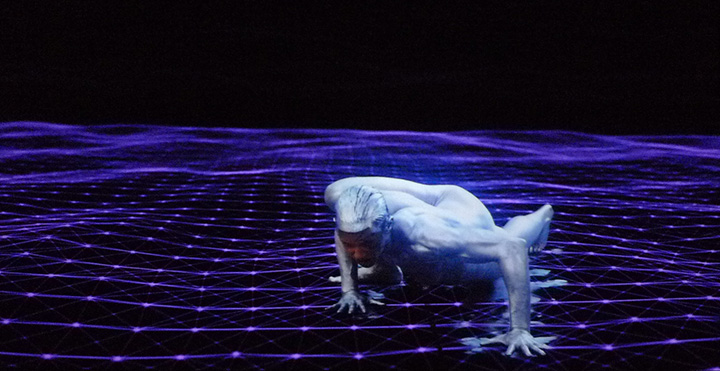Archive for the ‘critical_perspectives’ Category
Question of Intelligence
Before COVID-19 shutdown New York City, I had the opportunity to experience the exhibition “The Question of Intelligence – AI and the Future of Humanity” curated by Christiane Paul at Parson’s Kellen Gallery. I did not enter the exhibition expecting to witness disparate algorithms animating the exhibition space. It took me a few minutes to realize that the empty gallery (populated only by myself and two silent gallery sitters busily working, I suppose, on their school work) was brought to life by artworks forced to listen to one another and respond. I’m talking about artworks sensing via microphones, cameras, the internet; processing through artificial intelligence, machine learning, algorithms; and communicating via speakers, projectors, screens, printers, the internet and miniature swamps.
Christiane Paul has assembled elder artificial intelligence artworks over 40 years old (though still learning) with nascent works just starting to realize themselves. With the popular explosion of catch phrases including “Big Data,” “AI,” “Machine Learning,” “Today, right now, you have more power at your finger tips than entire generations that came before you…” (I used to appreciate Common before the Microsoft commercial, now I cringe when I hear his voice), Paul has curated a learning experience that recognizes the generational history of artificial intelligence as a creative medium.
Upon entering the gallery, one hears female artificial voices generating poetry or relating temperatures and soil humidity and other environmental measures or in the distance an occasional tweet. To the left, I saw a big black microphone and elected to approach it as the first means toward interactivity. I introduced myself and then watched my words projected onto the wall along with Chinese-style landscape paintings. Trails are drawn from word groupings to word groupings along with drawn landscapes and icons forming a word and image map. The projection is a mind map generator based on the words captured by the microphone. Following a few phrases, I decided it wasn’t very interesting and decided to move on. Adjacent to it is Lynn Hershman Leeson’s chatbot Agent Ruby (2001), but having interacted with one of Leeson’s works at Yerba Buena’s “The Body Electric” recently, I only spent a minute with it before moving on, also it didn’t know what to make of what I was telling it.

Adjacent to the chatbot, is Lior Zalmanson’s “image may contain” in which the artist feeds historically significant images into FaceBook’s Automatic Alternative Text image recognition algorithm, an accessibility AI to help contextualize images for the blind and sight impaired. The artists uses the uncontextualized and minimal description of the historical images to identify “similar” images and then collapses them onto lenticular prints. Above are the images that appear in the first print as I move from left to right. The work simply and clearly shows that bots such as AAT should not be used to present information and least of all pretend to be a source of knowledge, at least not yet.
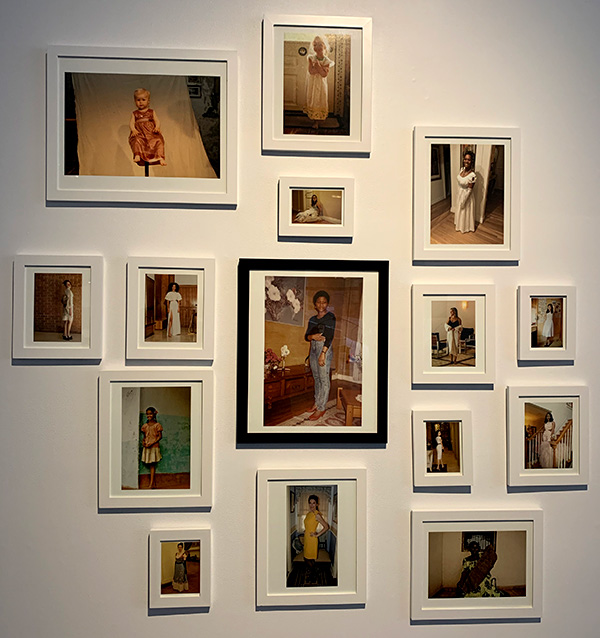
Similarly, Mimi Onuoha uploaded a photo of her mother “to Google’s reverse image search, which allows one to upload a picture to find online images that the Google algorithms identify as related.” Scaled, printed and framed from the initial image at the center to the algorithmically related images encircling, a seemingly family home portrait wall appears, leading one to question the process of algorithmic categorization based entirely on visual similarity. With such a project, I can’t help but recall eugenics and Sekula’s “The Body and the Archive.”
I then circled back toward the center of the gallery to try and figure out what was going on with “The Giver of Names” by David Rokeby. And it wasn’t until I read the instructions and changed the objects on the pedestal to assemble my own still life that the brilliance of the exhibition really dawned on me!
“The Giver of Names” (naming since 1990) consists of a monitor, speaker, old CCTV camera, pedestal, pile of old toys and a program that tries to understand what it is seeing through the camera to generate poetry. Once I removed the toys left on the pedestal and placed my own selection, I watched the AI go into action by identifying shapes and colors and then trying to make sense of what it was identifying or “seeing.” Those shapes and colors feed a poetry algorithm that speaks and writes to the monitor adjacent to the CCTV camera. Meanwhile, just beyond this installation, the not very interesting mind mapping microphone is also capturing this generated poetry as it echoes across the gallery and starts mind mapping away. AWESOME! The gallery is its own loop of machines churning away at one another’s utterances. This realization helped me refocus my attention and expand my time with each work. I tried to capture this in the video at the top of this entry.
Near the entrance on a wall monitor, hangs AARON which I had merely paused at for a few seconds but now returned to observe. “AARON is the earliest artificial intelligence program for artmaking and one of the longest running ongoing projects in contemporary art. Harold Cohen started creating AARON at UCSD in the late 1960s and developed the software until his death in 2016. In this video AARON produces a new color image every 10 to 15 minutes.” As one tours the gallery, AARON is quietly working away creating shapes and lines of color, artful abstractions.
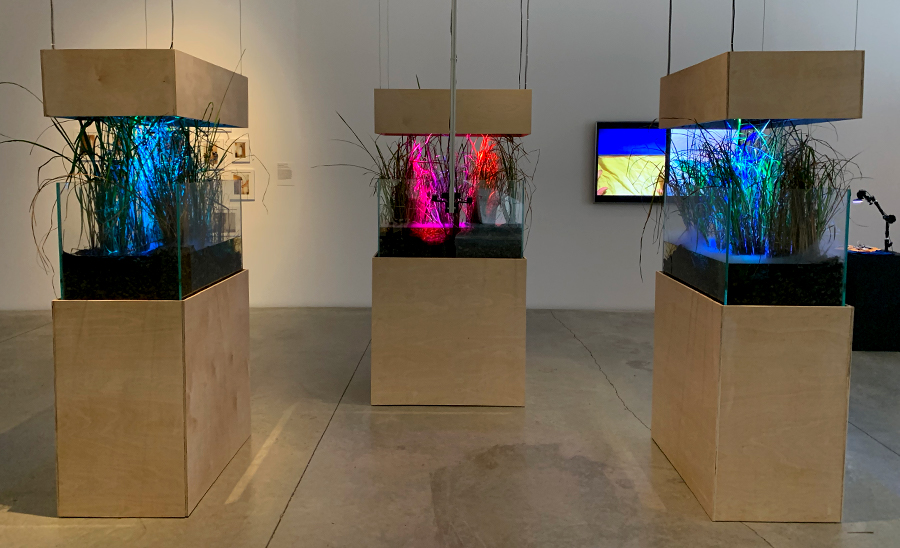
Back near the center of the gallery, just beyond “The Giver of Names” is another work with a female computer voice speaking at intervals. Tega Brain’s “Deep Swamp” asks “if new ‘wilderness’ is the absence of explicit human intervention, what would it mean to have autonomous computational systems sustain wild places?” The handsome installation has three AIs, Nicholas, Hans and Harrison each “engineer their environment for different goals. Harrison aims for a natural looking wetland, Hans is trying to produce a work of art and Nicholas simply wants attention.”
“Learning to See” by Memo Akten uses machine learning to relate the objects on a pedestal that a camera captures to five different data sets that the system has been fed. The visitor can re-arrange the objects on the pedestal to see new interpretations. Across from the pedestal on a wall is a split screen that shows the image captured by the camera adjacent to the system’s interpretation. “Every 30 seconds the scene changes between different networks trained on five different datasets: ocean and waves, clouds and sky, fire and flowers, and images from the Hubble Space telescope.
Similarly across the gallery, hang a series of prints by Mary Flanagan. The work is [Grace:AI] in which generative algorithms trained on thousands of paintings and drawings by women to create a series of images. “[Grace:AI] was tasked to create her ‘origin story’ by looking at 20,000 online images of Frankenstein’s monster and producing its portrait.”
Both “Learning to See” and “[Grace:AI]” employ generative adversarial networks (GAN), to generate new visualizations. Using GAN anyone can put their own conceptual spin to generate a data set for the machine to learn and see what it spits out. Over the last few years, I’ve seen a few similar projects, my favorite remains an early one – the MEOW Generator trained on a cat dataset.
Perhaps the most darkly monumental project are the large four black machines with spinning fans, exuding steam and ticker tape – the installation component of #BitSoil Tax by LarbitsSisters. The project proposes the fair redistribution of internet wealth to all people through a new taxation system. The installation is utopian, dark and whimsical.
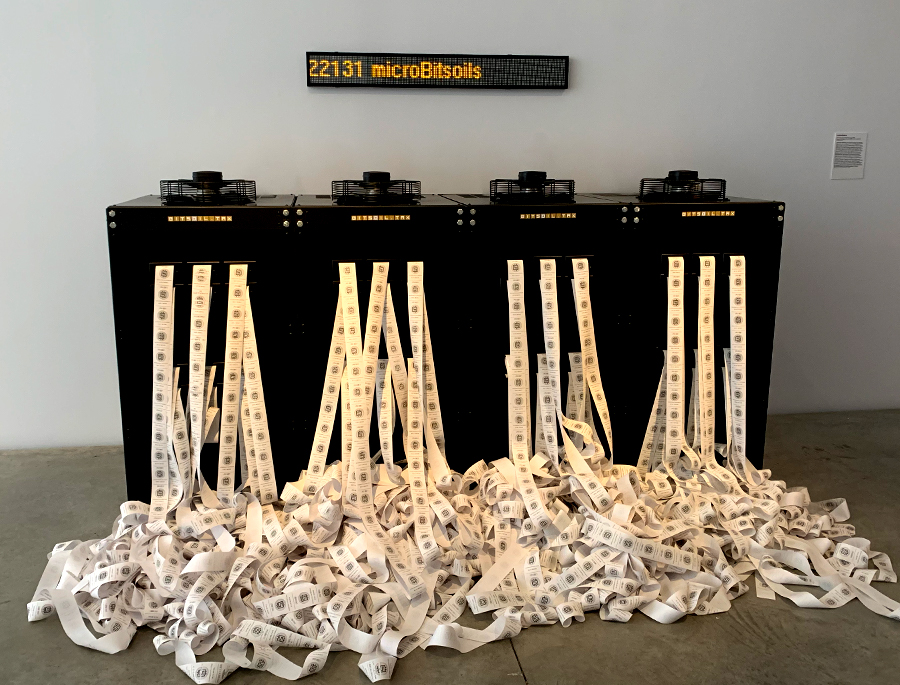
Other projects on exhibit include “Futures of Work” by Brett Wallace, and Ken Goldberg and the AlphaGarden Collective.
Cuban Girlfriend for Rent

Friday April 26th, 2019, I had arrived in Camaguey, Cuba the previous day for the city’s video art biennial. Earlier this day, I presented a virtual reality piece – “Incertidumbre” outside the biennial’s theater – on the street in a small public square. It was a big hit with unsuspecting pedestrians, not so much because of the content, but rather because no one had tried virtual reality, so people were awed. Throughout the two-hour duration of presenting the work, there was a line, so that evening I decided to treat myself to a nice dinner at a restaurant that I had enjoyed on my last visit to the same biennial. I requested a seat on the rooftop deck as it was not too hot and I could enjoy the view of the city with its rooftop ceramic tiles and many church towers as the sun set.
I had the patio to myself until a couple arrived – a man perhaps near 50 with a young woman, perhaps in her late teens. As I was alone, I couldn’t help but overhear their conversation. He spoke with an Argentinian accent as he told her about his latest travels – business travels around Western Europe and South America. His voice was deep and aggressive, not particularly pleasant to listen to. He was a large bald white man who stood over six feet with a decent belly and skinny legs. His v-neck t-shirt with a pattern of sailboats was a bit too tight. She was a beautiful light-black young woman with an hourglass figure. Her large firm breasts shaped nicely her fitted dark tank top.
The large bald white man talked about flying first class, the delicious champagnes that he was served. He told her that in first class the seats fully recline. He would down three or four champagne glasses, transform his seat into a bed and put himself to sleep. He told her about the sporty BMW that he rented to travel around Spain as he had meetings in Madrid and Seville. He said his business was doing well, described how busy he has been, and that he was glad to be back in Camaguey to relax. He talked on and on while she remarked in awe but with a tinge of boredom. For the most part, she merely listened. Until he paused with a complaint – that he had been telling her all about his life and travels and she had not told him about her life – what she has been up to, details of her life…
At this she replied with a hint of frustration – “you already know all about my life. I get up, go to school, after school, I do sports until it’s time to go home for dinner, and then I study until it’s time to go to bed… That is my life, I don’t go out, because I’m too busy with school and athletics. I’ve already told you all this…”
At this point, I couldn’t help myself but shift my chair a bit and pretend to take a selfie with them in the background. It was a stereotypical reality that one hears about and sees upon visiting Cuba – older men from abroad paying girls for their time and bodies. It was clear that they knew each other and that they are together when he is in Camaguey. Perhaps he maintains her by regularly sending her money and in exchange she is his when he is in town.
I finished my dinner, particularly enjoying the plantains stuffed with shrimp. I had had those before and upon entering the restaurant, they immediately came to mind. I requested the bill from one of the waitresses – two and at times three had been hanging around the patio as the downstairs was empty and the only patrons were myself and the older bald white man with the beautiful girl.
Nicaraguan LGBTQ Community
I recently read the essay “Tacit Subjects” by Carlos Ulises Decena in which the author interviews several homosexual individuals from the Dominican Republic. Decena focuses on the coming out or not of gay Dominican men to their families. Amongst the subjects interviewed for the essay, their homosexuality is unspoken but recognized by their family members, hence the title “Tacit Subjects.”
Upon reading the essay, I was immediately transported to the awe that I felt in 1995 upon witnessing my first Torovenado in Masaya, Nicaragua. Throughout my life I had only visited Nicaragua during the summer and I had enjoyed the initial celebrations of the three month festivities for San Jeronimo, the patron saint of my mom’s hometown – Masaya. El Torovenado – a satirical procession occurs at the end of the celebrations – the final Sunday of October. In 1995, I moved to Nicaragua for an extended period and the uncle with whom I was living, invited to take me to El Torovenado. Mi Tio Jorge enjoys a good party and is not particularly religious, so I was a little surprised that he’d want to go to the culmination of a saint’s festivities. However, I noted a mischievous spark in his eye and I agreed to join him on the 20 minute drive to Masaya.
I was dumbfounded upon seeing a giant gay parade in my mom’s hometown. It was as if the San Francisco Castro that I grew up with had transported itself to Masaya. There, before me, was the Lion’s Club (El Club de Leones) Queen – queen of the parade – a proper queen, entirely in beautiful drag. Everywhere I looked the rainbow flag was flying high. I think my uncle truly enjoyed at how speechless I was.
The culmination of this Catholic festivity had been co-opted by the gay community and everyone appeared to be fine with it. Since El Torovenado is a satirical procession in which people are allowed to mock anything and everyone – from historical figures to the most powerful political figures, in retrospect, it makes sense that the gay community took over this particular day of celebration; after all it’s a day of freedom, when social norms are discarded. El Torovenado is alternately called La Parada de los Cochones.
I feel that Nicaragua has always been more accepting of its gay community than other Latin American countries and I think that the 1979 victory of the Sandinistas allowed greater freedom for the LGBTQ communities through the 80s. The Torovenado allows the large numbers of the gay community to gather and party. Here is a 5 minute video documentation of the 2017 Torovenado (before the current Ortegista repression and militarization of the country):
In relation to the gay Dominicans featured in “Tacit Subjects,” these are people (primarily men) who are out and proud and the public persona that they present particularly in a festive procession may be very different than who they are with their family. Perhaps the acceptance of the gay community in Nicaragua allows young people to come out and discuss sexuality more openly than in the DR and it is not such a tacit subject. However, macho culture exists as in the rest of Latin America and I would not be surprised if a large portion of this community is alienated from their birth families and have constructed or adopted new families based on their sexuality.
There is an interesting book that I’ve only read passages from that goes in depth regarding the gay community following the Sandinista revolution – Intimate Activism: The Struggle for Sexual Rights in Postrevolutionary Nicaragua by Cymene Howe. The book discusses El Torovenado:
according to Erick Blandon, the Torovenado is a ‘moment of escape from oppressive heterosexual masculinity and a dialogic engagement between different sexual subjects where homoeroticism becomes the center of attention for both homosexuals and heterosexuals.’ While transvestics are not the quotidian norm in Nicaragua, it is clear that the country has had a public and symbolic space for these kinds of gendered performances.
Howe, Cymene, Intimate Activism: The Struggle for Sexual Rights in Postrevolutionary Nicaragua, Duke University Press, 2013
With the current violence and repression by the Ortega dictatorship, I wonder how the LGBTQ community is doing. Have they become a tacit community? Are they remaining in-doors as does the majority of the population come nightfall? The LGBTQ Nicaraguan population has largely thrived due to the safety and acceptance of the country, but with assassins trolling the streets, freedom and expressiveness may no longer be available. It is so sad that the military leaders will allow a single couple – Ortega and Murillo hold an entire country hostage and have destroyed the legacy of a popular revolution.
Dictator Cycle
The series of work titled Dictator Cycle has a specific moment of inception – January 29th, 2014 when I heard that the Nicaraguan National Assembly had elected to do away with presidential term limits, effectively allowing, the current president Daniel Ortega to remain president throughout the remainder of his life.
With each manipulation of the Nicaraguan constitution by Ortega and the Sandinista party, I feel a deep sadness for the impoverished country, the birthplace of my parents and where I spent the best days of my childhood. I am also dumbfounded at the short-sightedness of the ruling party and the ignorant avarice of Daniel Ortega who will not hand over the political reigns of the country to a new generation.
Prosperity has been illusive to this small country that has suffered a long-lasting dictatorship, natural disasters, a popular revolution and seemingly inherent political corruption. If only true leaders would emerge who seeks an end to corruption and the engineering of a society striving for the well-being of all its people. Unfortunately, since the Nicaraguan National Assembly elected to eliminate presidential term limits, an end to poverty and corruption appears as distant as the worst period of the Somoza dynasty. Ortega has effectively become Somoza.
Nearly a year later, I illustrated Stalin/Putin out of anger of the increasingly draconian laws in Russia such as the “bloggers law” and “anti-gay law”. Following Stalin/Putin, I started work on the “Dictator Cycle” as an illustrative series depicting once young and noble leaders who had become corrupt autocrats unwilling to surrender power. Each “Dictator Cycle” pairing is alive today or their reign continues to have very real consequences upon the country. For example, although Gaddafi has been killed, Libya continues in disarray. Although Kim Il-sung died in 1994, his grandson Kim Jong-un is North Korea’s current supreme leader and is shown to perhaps be the most ruthless of the family dictatorship.
A Case for Latinx
Coined in the early aughts, the term Latinx has slowly gained traction in academe and social media. Spanish is a gendered language, nouns are either female or male – they are binary and immediately evoke a binary gendered meaning and identity and value – female or male. To those who identify outside of the female and male binary, a transformation of language must occur.
Language is a living thing. Languages change over time; new words are established, pronunciations change, languages die and new languages are established; language evolves. In Judeo-Christian religions as well as other religions, language is the root of knowledge and language is power. In our culture, those who dominate a language may more easily cross class and racial boundaries. Language continues to present power.
As language is knowledge and power and language is a living thing, it can be transformed. Language is a culturally transformative vehicle. Language has the power to alter understanding and may present a means to inclusiveness. Perhaps next year the Latinx Grammys will embrace this transformation.
Amazon Is Funded, CUNY Is Not – Shame de Blasio
The hypocrisy of the NYC Mayor: today on WNYC’s “Ask the Mayor” de Blasio states that CUNY 2-year grads will be able to get $50K jobs with Amazon (which he declares is a living wage in NYC, I’d like to see de Blasio get by on $50k). Meanwhile CUNY is severely underfunded and falling apart. CUNY state support has declined for decades. In 2017, City Comptroller Scott Stringer testified that “since 2010, CUNY’s cumulative shortfall in State funding is now over $700 million.” The 2018 $200 million “boost” for CUNY AND SUNY (again – a lousy $200 million for both SUNY and CUNY) for a “quality education”, trickles down to nearly nothing in correlation to the decades of underfunding. The fact that Amazon, an over $130 BILLION corporation, is awarded $3 billion in tax credits, abatements and capital grants from the city and state while CUNY is severely underfunded year after year is SHAMEFUL!
As the mayor stated, a rational for this is the job creation that the Queens’ based Amazon headquarters will present to the city population. However, if CUNY continues to be underfunded, if the vast majority of our faculty are underpaid, if classes are over-stuffed with students and education must be watered-down, these jobs will not be filled by CUNY grads. Amazon jobs will be filled by private university grads and grads from across the country that receive a better education than what CUNY can possibly offer on a short budget. And the disparity between privilege and poor will continue to grow – as sponsored by Cuomo and de Blasio.
It is shameful that adjunct faculty must fight and protest for a lousy $7K salary when Amazon is awarded billions of dollars. We all know that Cuomo does not value public higher education, his record clearly shows this, but it’s shameful that the so-called progressive de Blasio does not do more to fight for CUNY.
Pope.L Bougie Irreverence
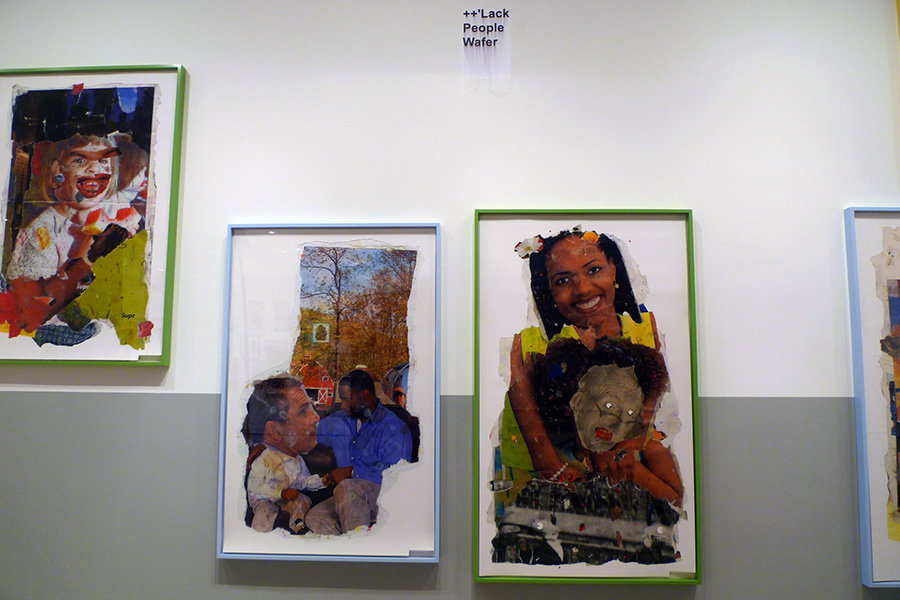
It is difficult to call any art placed in a blue chip Chelsea gallery irreverent, but Pope.L tries his best. Currently (9/13 – 10/27 2018) at Mitchell-Innes & Nash, Pope.L “One Thing After Another (Part Two)” stocks the gallery with collaged digital prints, framed found trash, assemblage, photo-collage, and a video of an erect penis attempting to balance a white whip cream pie. (As you might guess, the cream pie tips off the big, hard, black dick; only Brett Kavanaugh’s small white penis would hold that pie up.) The video is hilarious and I wish I had recorded a bit of it to include it here. It is a sharp and whimsical comment on desire, sex, race and privilege or rather lack of. The white pie and black dick are accompanied by a smoking digital black sock puppet that rises and forms like a snake from a corner of the video image.
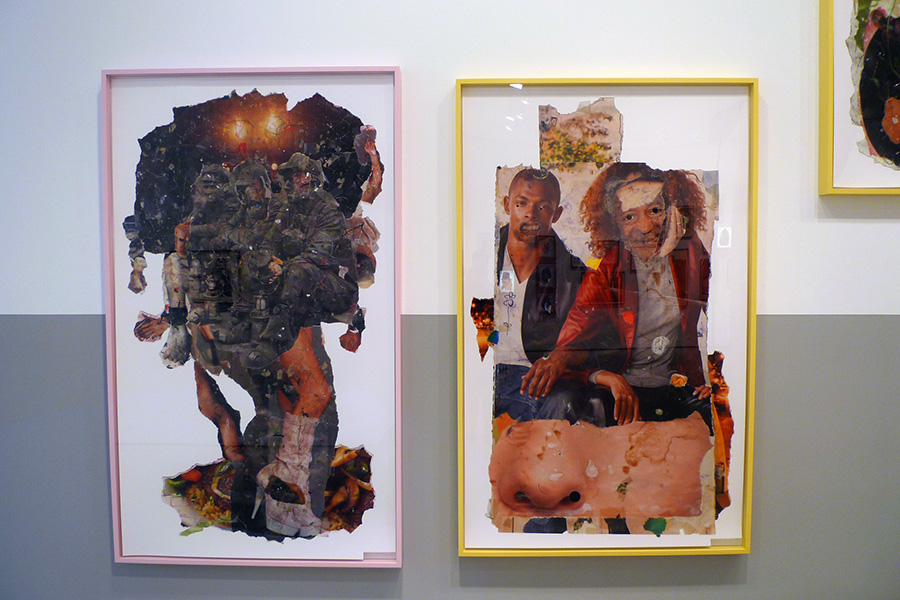
The digitally printed collages tear apart political and celebrity figures, mockingly reframing them in unexpected contexts and pairings. Across the gallery, William Pope.L has inserted himself into historical photographs. Again, the visuals are at once comical and critical recontexualizing a problematic racial history of the United States.
Pope.L effectively reminds us to always look at the images we are fed with a critical eye. Question the images – where are they coming from, why are they being presented and what is it that they represent? What is our place in this culture? But in the end, lets not take ourselves too seriously, be creative, have fun, but always be smart.
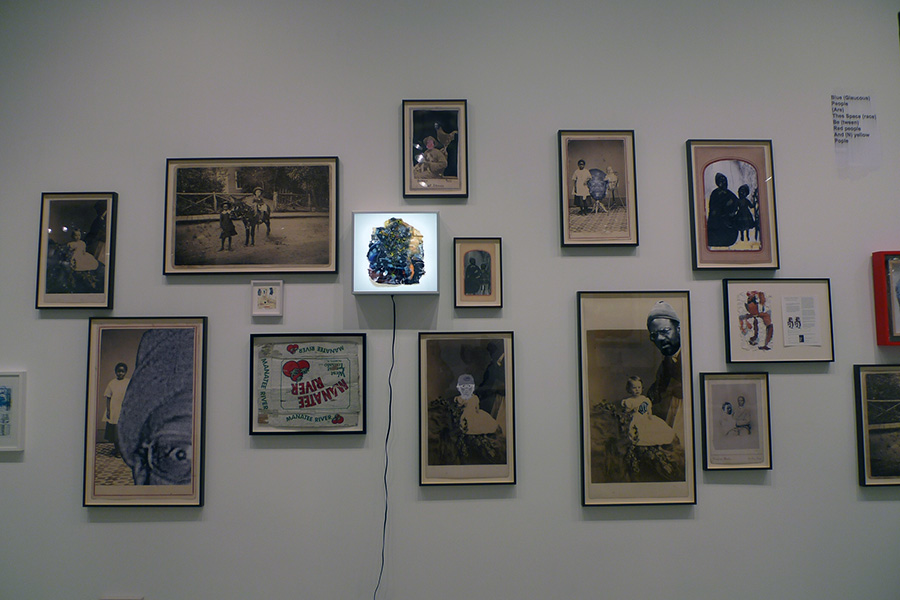
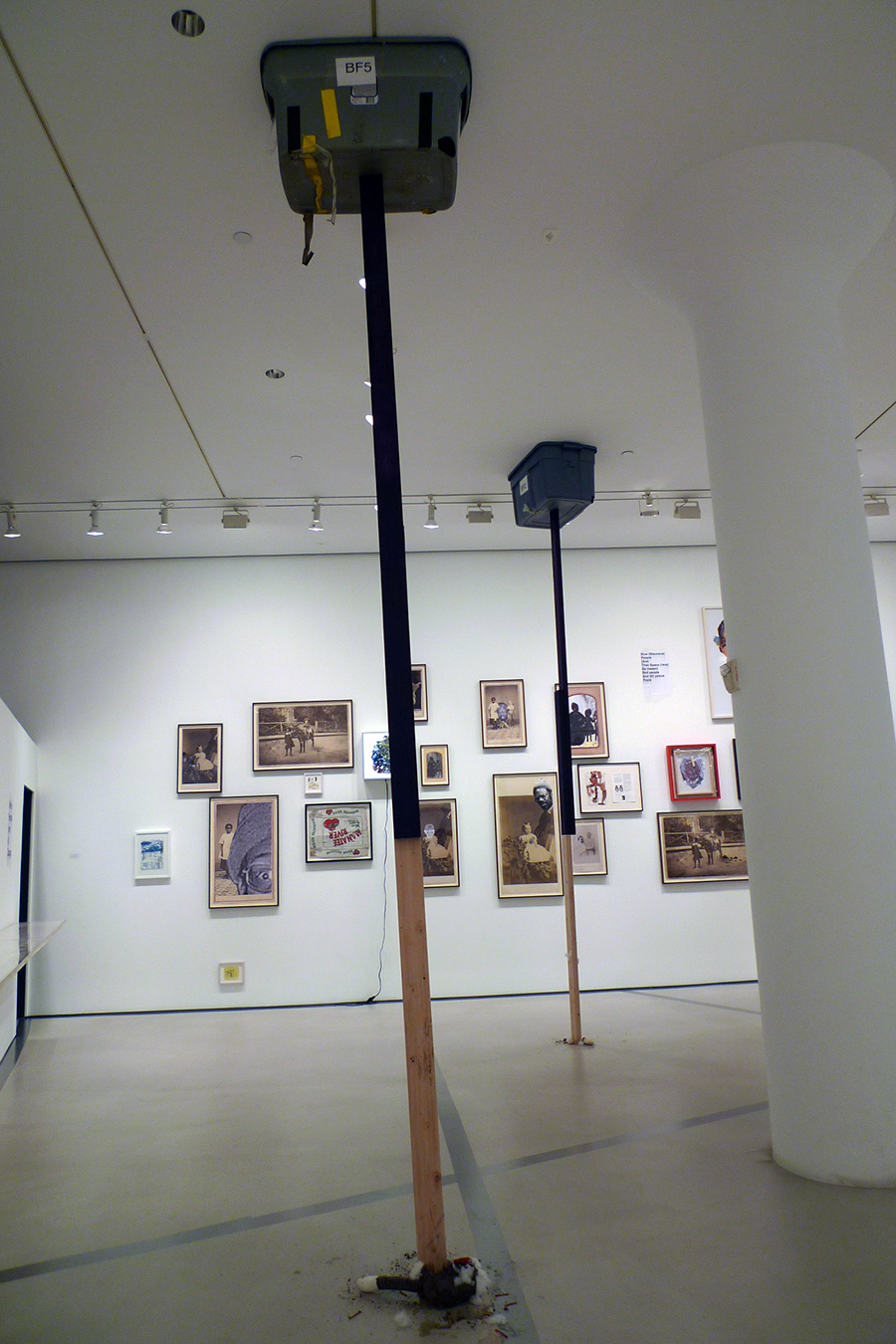
NEGOCIO at Centro Cultural Las Cigarreras de Alicante
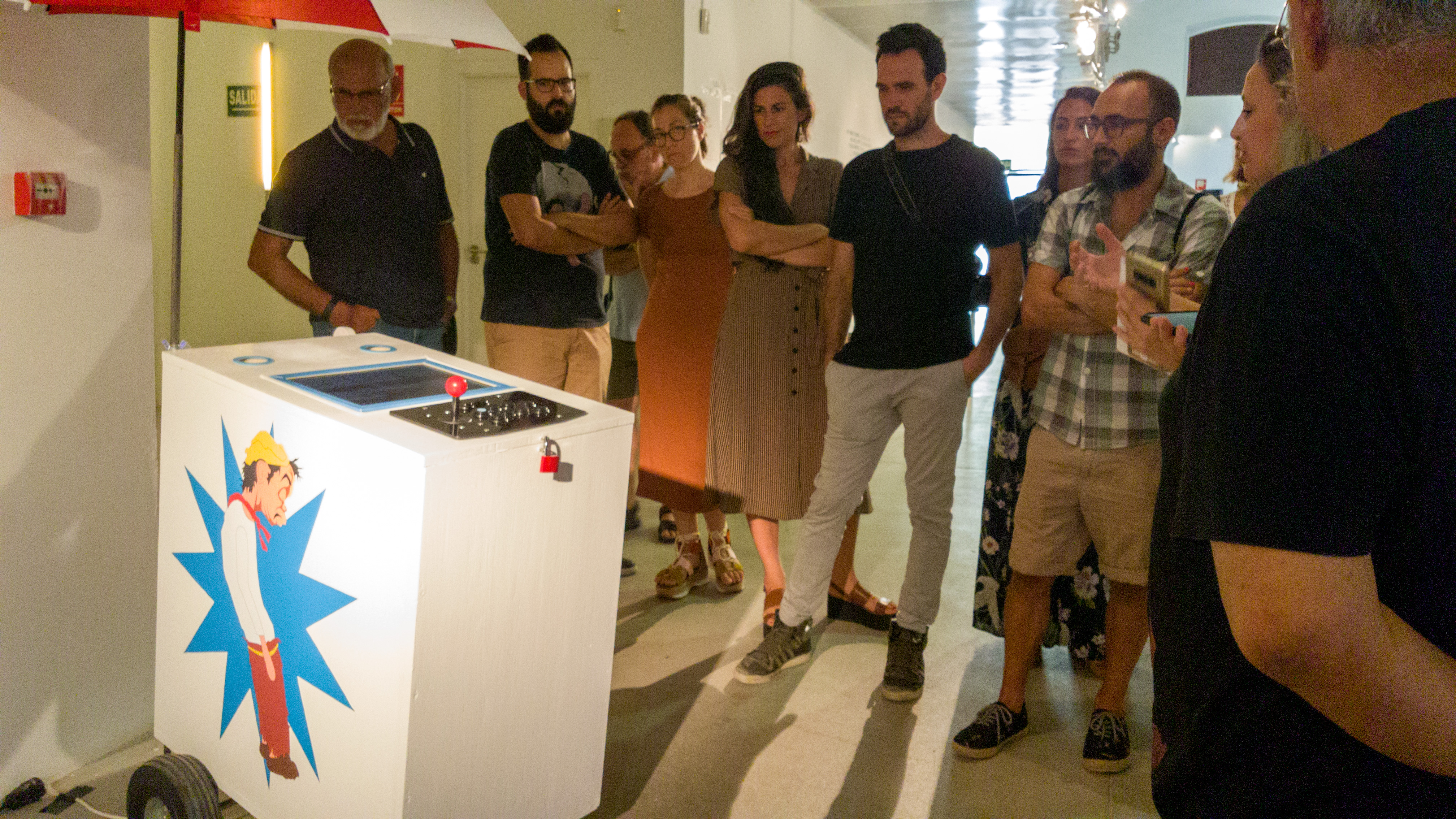
NEGOCIO at el Centro Cultural Las Cigarreras de Alicante is an ambitious attempt to present an archive of the creation of games as art largely over the last twenty years, though one work – “White Chess” by Yoko Ono dates back to 1966. The majority of works have been created in the 21st century. The exhibition presents a mix of digital and analog games and the vast majority of the exhibition is interactive – allowing visitors to play the games on exhibit as intended by the artists.
I’ve been honored with the inclusion of VAGAMUNDO: A Migrant’s Tale (2002) included the exhibition (pictured above). This is a sculpture and video game originally presented on the street that unfortunately is as timely today as 16 years ago due to the Trump administration’s stance regarding immigration.
The curators – David Machado Gutierrez, Alba Garcia Martinez, Beatriz Martinez-Villagrasa and Miguel Soria Andurell state:
The origin of the game, is lost in the memory of time; the game is perhaps as old as the very existence of the human being on earth. But what does the game transmit to us today apart from its playful appearance? Can art use it as a tool that reflects on challenges and social reality? Does it also work as an act of criticism? This exhibition does not pretend not to answer these questions, since it would be too ambitious, but it is formulated so that the spectator participates and, using the works of art as a guide. The exhibition investigates in the multiple planes what may unfolds in games as art.
Below are a selection of photographs documenting the exhibition.
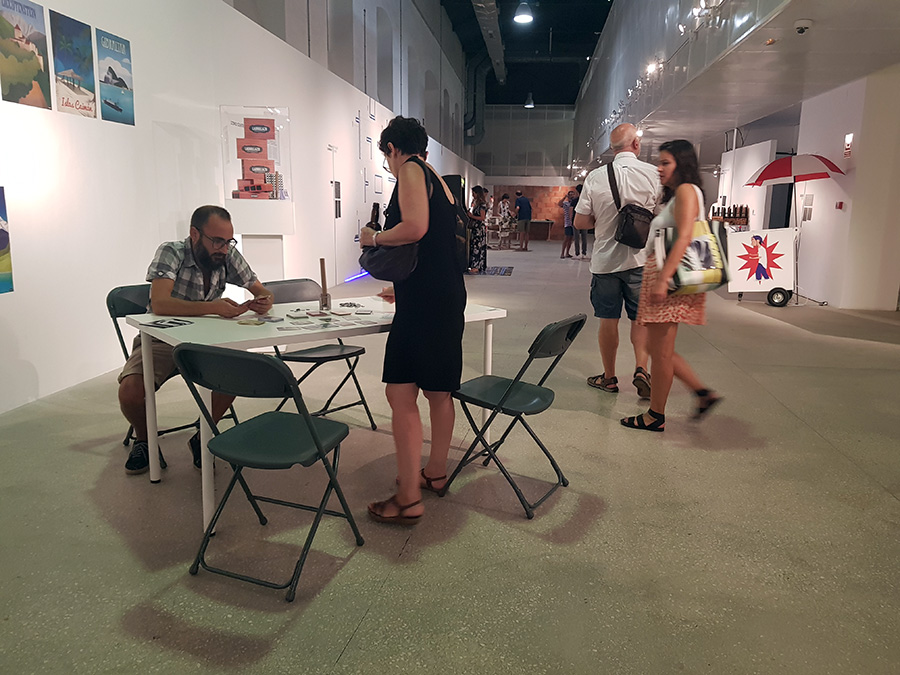
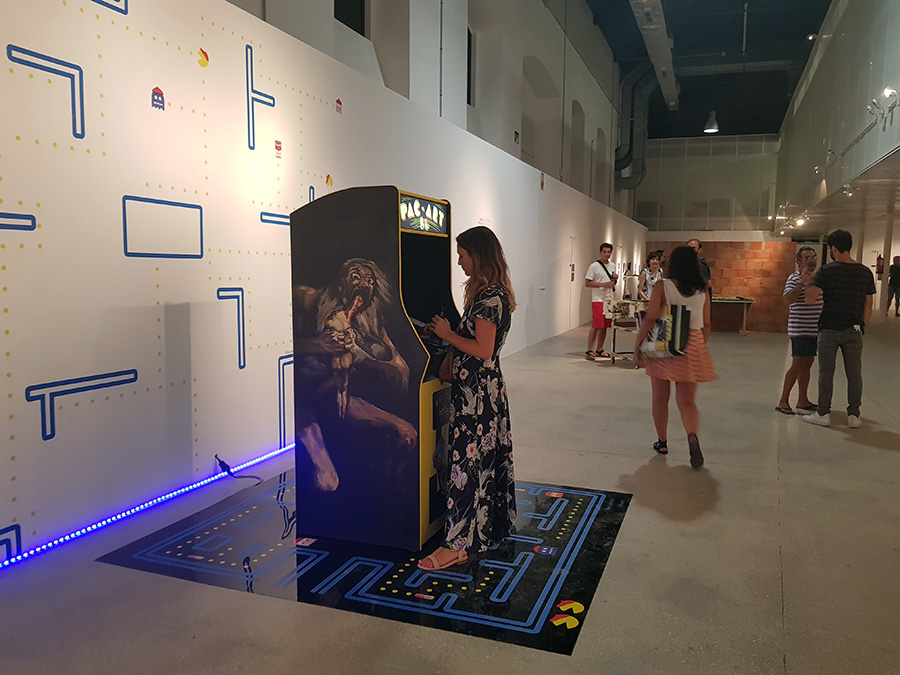
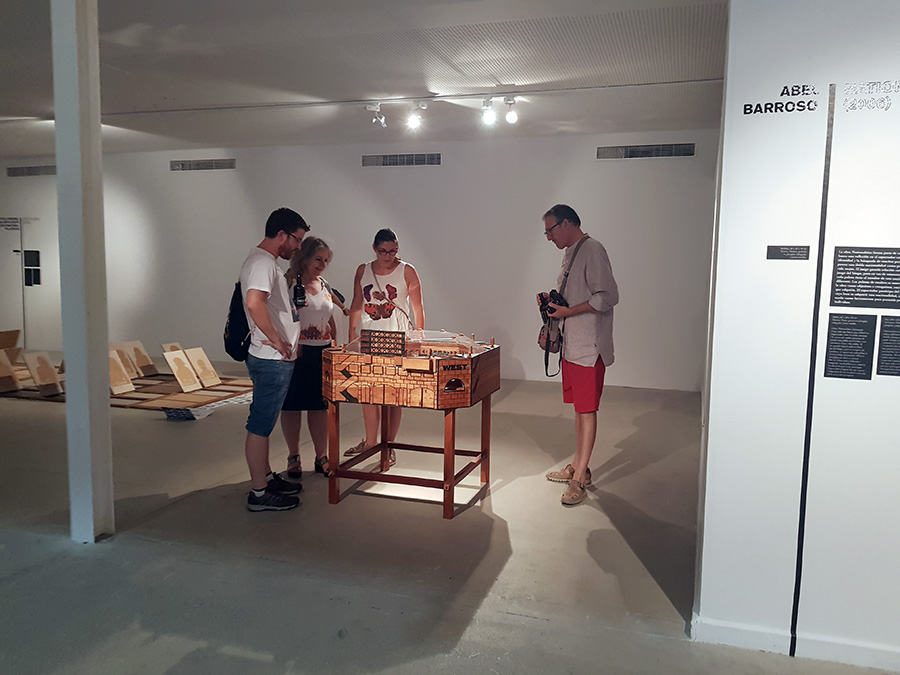
Two game sculptures by Cuban artist Abel Barroso
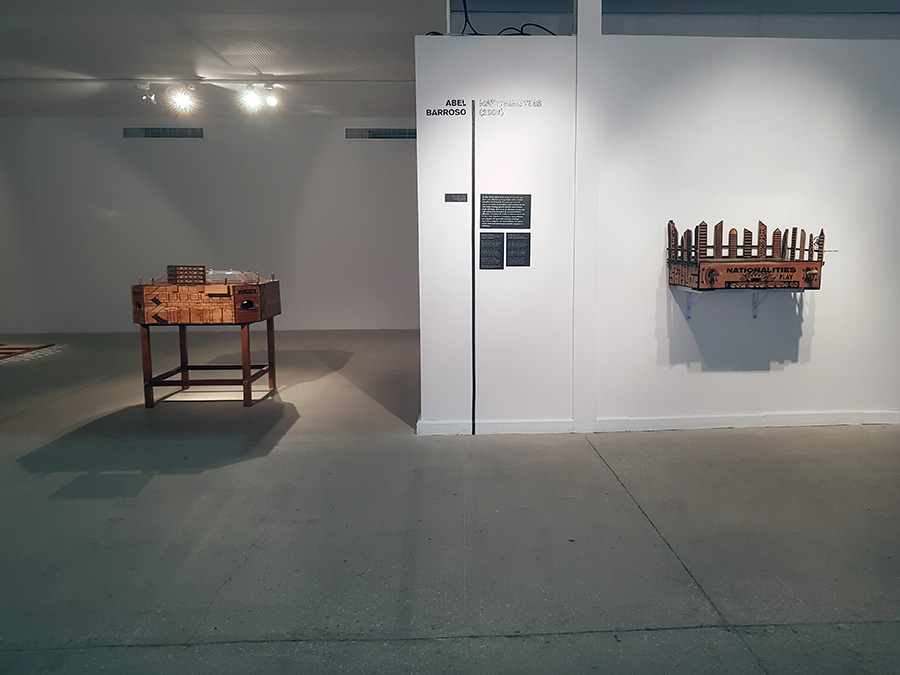
Carlos No’s Intifada – a “ping-pong table which, in place of a net, has been divided into two halves by a very high brick wall, topped by barbed wire that heightens a feeling of insurmountabilty. There arises in the spectator the curiosity of seeing the other side, the place which one is forbidden to see and be in, as if one had discovered Lewis Carrol’s charade in the passage to the other side of the looking-glass. In this wonderland that comprises this side and the other side, both the space and the visitor’s steps are divided into two.”
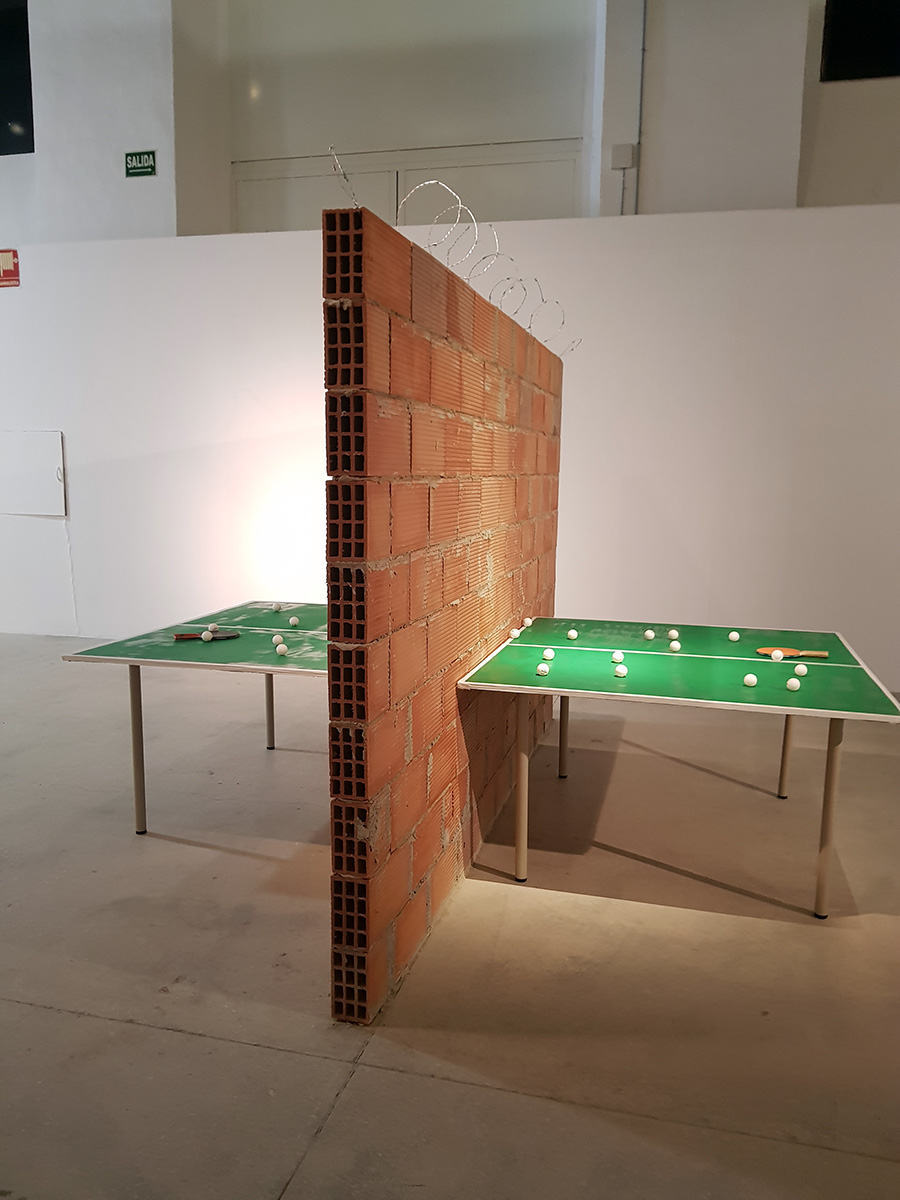
“Velvet-Strike is a mod of the first-person shooter video game Counter-Strike. The mod, developed by Anne-Marie Schleiner, Joan Leandre, and Brody Condon, adds “protest sprays” to the game’s existing graffiti function.”
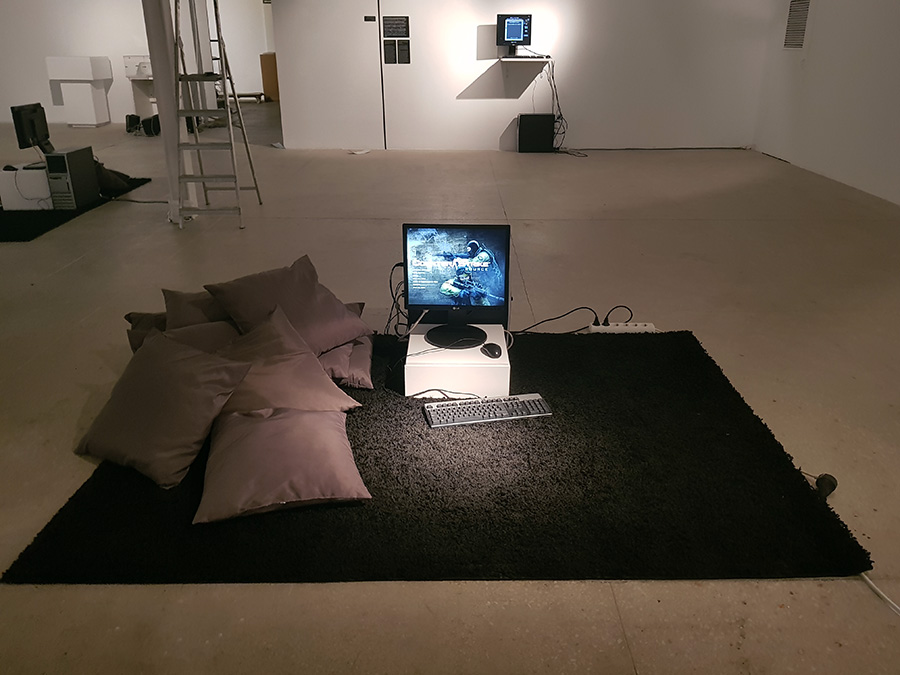
“Ladrillazo is a historical game that takes you to the real estate bubble of the first decade of the 21st century. There were days of wine and roses, an interpretation center in each town, an airport in each city, mortgages at 40 years, masons with minister salaries, Olympic dreams, AVEs and golf resorts.”
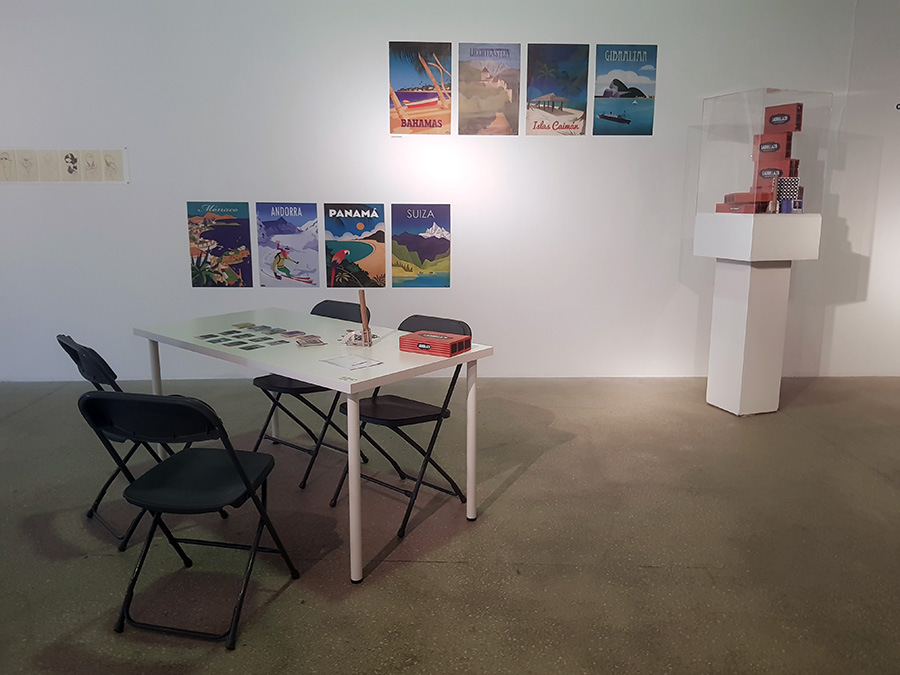
“Pac-Art is a version of the immensely popular Arcade video game Pac-Man. In this case, Pac-Art has transformed Pac-Man into an artist who has to devour famous works of art and flee from ghost-artists who threaten him.”
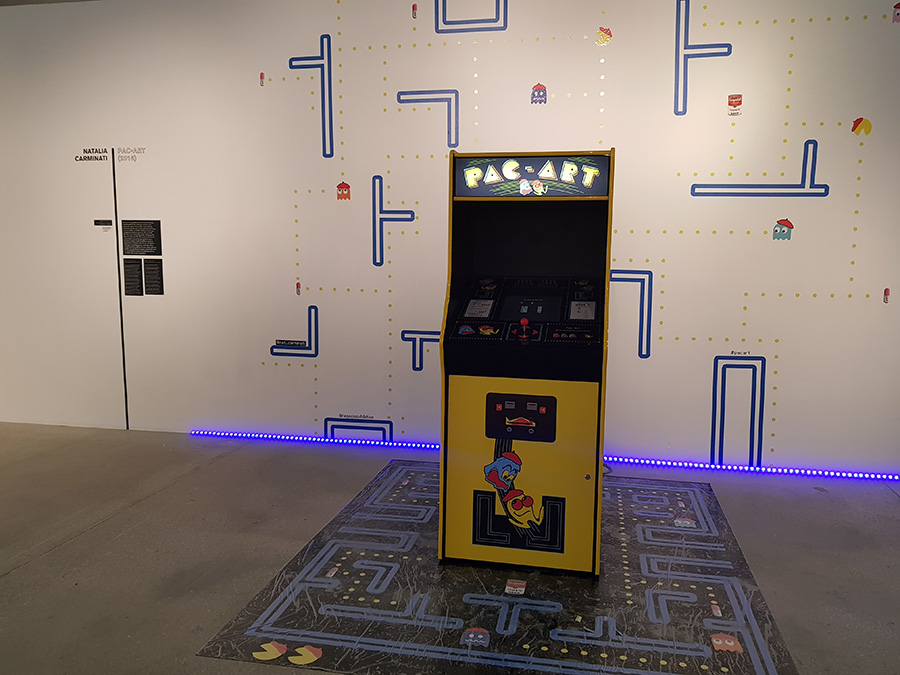
Ravalpoly by Alba Refulgente – a game of real estate speculation in Barcelona that re-contextualizes the game Monopoly.
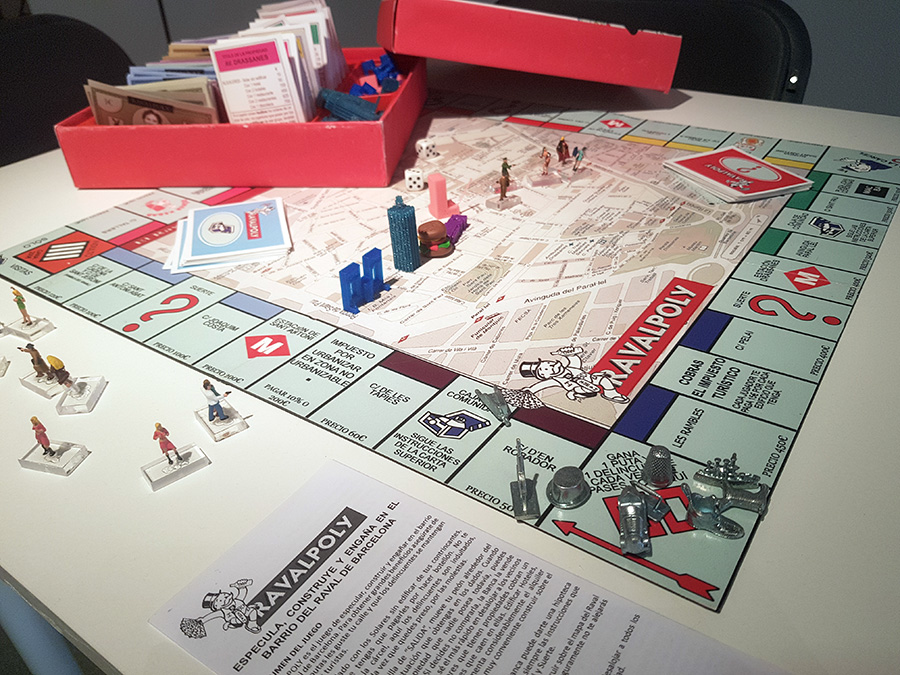
Visitors will have the opportunity to play Yoko Ono’s “White Chess.”
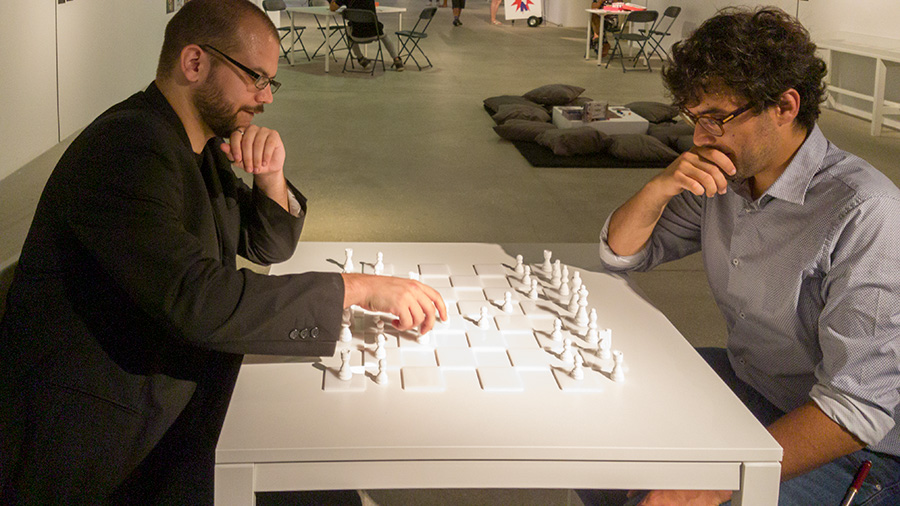
Many other artists and game makers are included in this exhibition, including Brenda Romero, Connor Monahan, Molleindustria, Richard Hofmeier, Jason Rohrer, Joan Priego amongst others. And one more image of VAGAMUNDO:
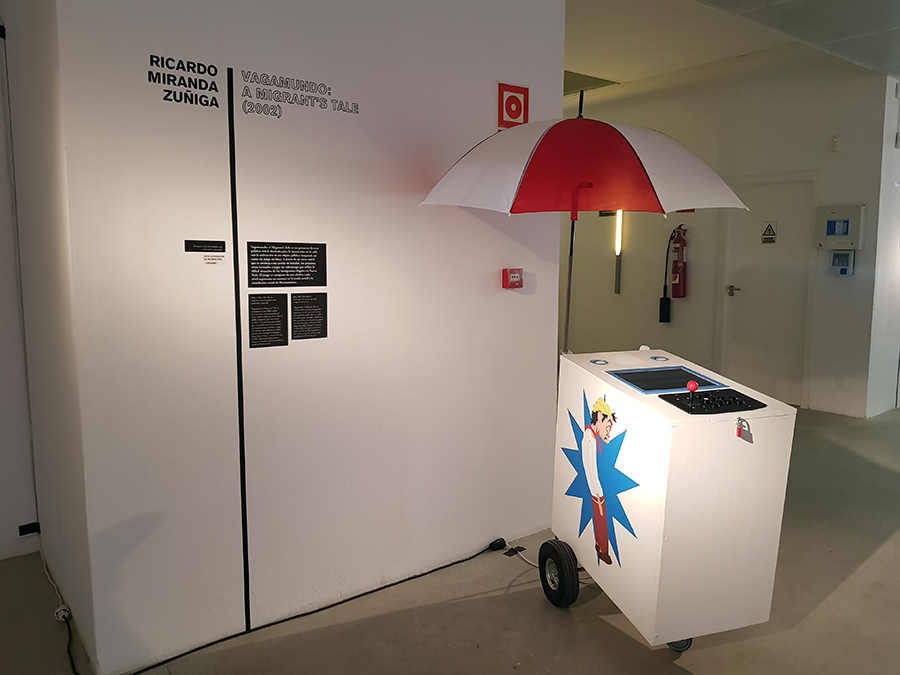
Northeast Exhibitions Editor for caa.reviews
Over the past year, I have been working as the Northeast Exhibitions Editor for caa.reviews and thus far it’s been a great experience! Fortunately, my job is relatively easy or perhaps better stated fun. I search out exhibitions that deserve to be reviewed throughout the Northeast (but not including NYC). As I find, important exhibitions, I then need to identify potential reviewers. I had heard that commissioning non-paid reviews from people was difficult, but thus far, I’ve been able to quickly find writers or have people even volunteer reviews for exhibitions that they felt passionate about.
Once the writer and I agree on a deadline, we bounce the review back to one another to arrive at the final product. It has been a great learning experience to envision exhibitions that I have not visited myself through the writing of the reviewer. And as editor to work with the reviewer to create a clear sense of the exhibition and its power for readers who may as well not have the opportunity to see the exhibition first hand.
Thus far, I have had the pleasure to work with the following writers:
Valeria Federici on “Art in the Age of the Internet, 1989 to Today” at the ICA Boston.
Christopher Kasprzak who reviewed “Calder: Hypermobility,” at the Whitney Museum of American Art.
Ellen Handy who wrote an excellent review on “Clarence H. White and His World: The Art and Craft of Photography, 1895–1925” at Princeton University Art Museum.
John Muse on “Yoonmi Nam: Still” at Philadelphia’s Print Center.
There is more coming soon!
Zach Blas Contra-Internet at Art in General
Contra-Internet: Jubilee 2033 trailer from Zach Blas on Vimeo.
I had been looking forward to seeing Zach Blas’s Contra-Internet exhibition at Art in General, unfortunately it was not as engaging as I had hoped. The exhibition presents one single channel video installation that features the nearly 30 minute film “Jubilee 2033” and three other single-channel video works on monitors. The three video works on monitors present ideas and research regarding the internet – the hegemonic network of today and for the foreseeable future – through computer screen recordings by Blas. (I really hope that artists stop using screen-recordings of themselves clicking through files as a medium; it’s seldom interesting.)
Although I was disappointed by the exhibition, the gravity dance performance by Cassils as Nootropix, “a contra-sexual, contra internet prophet” is captivating an entirely worth the trip. The premise of the film is funny as it opens with Ayn Rand discussing the future of her ideas with two of her followers – Alan Greenspan and a fictional character Joan Mitchell. A young Greenspan proposes that the group take an acid trip. I was turned off by the highly accented performance of Rand and her cult, so I was glad to see them drop liquid acid.
As the trip begins, an internet connected artificial intelligence in the form of a manga character appears and takes them in to the future. The future is of course dystopian as the present reality burns and it’s certainly fun seeing the Google headquarters burning along with other tech companies in the not so distant future of 2033.
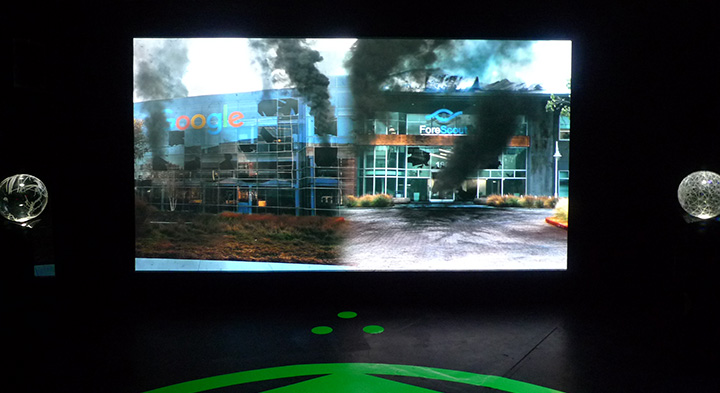
Along their travels, we encounter tech workers being taken hostage by “The Art Professor” wearing gray, paint-splattered coveralls and wielding a machine gun. Later in a classroom, the Art Professor introduces Nootropix (Cassils) who in their monologue states that they will perform the creation of gravity. The performance artist is powerful and their dance upon a purple matrix while dawning a large, erect, glowing CGI penis that is constantly spewing black liquid is awesome. The dance is mesmerizing and triumphant.
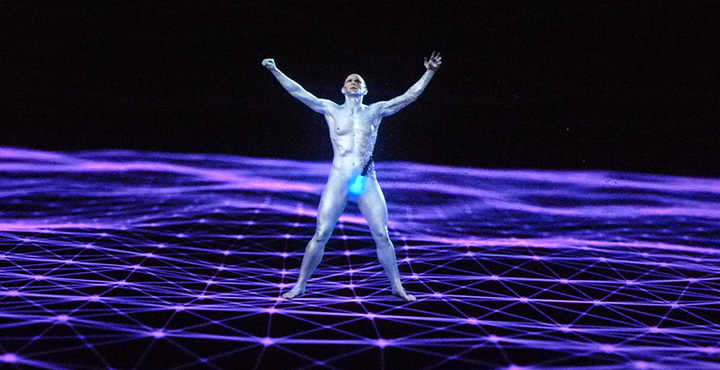
In Nootropix, Blas presents one of his contra-internet exotic creatures “to discover or create a world of network difference.” I could have entirely skipped the storyline, and merely be fantastically transported by Cassils’s character and performance as I think that it would have left me asking more questions and appreciating the mystery. We know that a network of difference is not plausible, so why not create the fantastic and shed the tedious philosophizing.
